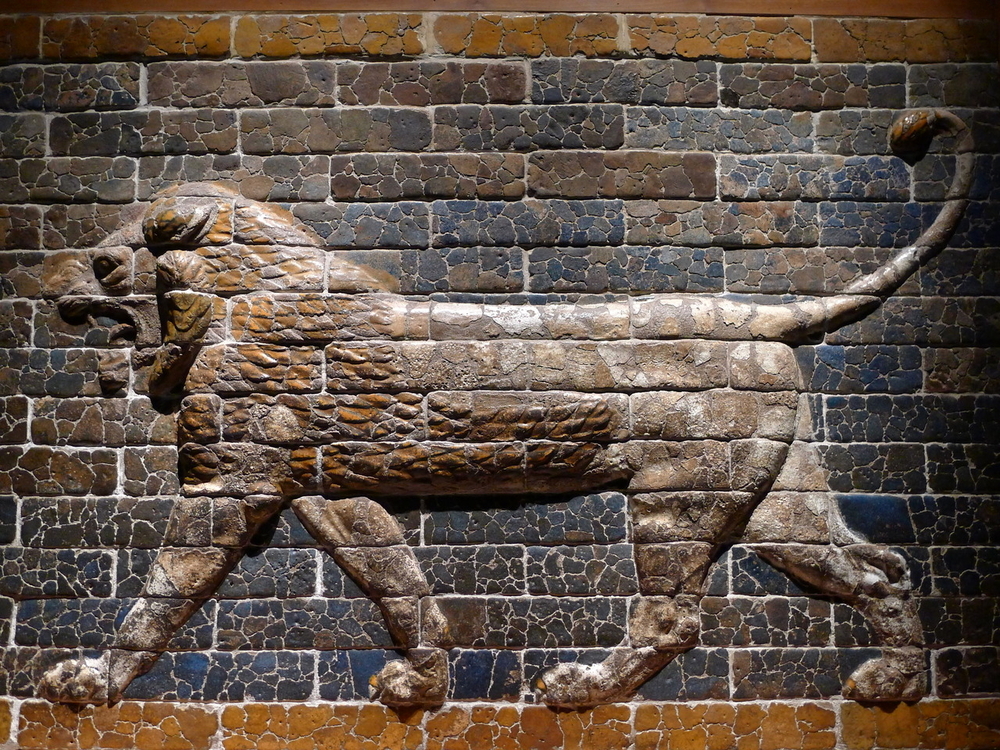









Symbols of kingship in ancient Mesopotamia included elaborate hair and beard stylings, even a stone ‘wig’.
There are some great shows in Toronto this summer. A must-see is Mesopotamia: Inventing Our World at the Royal Ontario Museum until January 5, 2014. This blockbuster exhibition features over 170 treasures from the acclaimed antiquities collection of the British Museum in London, England.
Mesopotamia (meaning ‘between rivers’) lay in the Middle East between the Tigris and Euphrates rivers, in what is mostly present-day Iraq. The ROM Mesopotamia show explores 3,000 years of artistry and innovation in ancient Sumer (4000-2000 BCE), Assyria (1000-600 BCE) and Babylon (600-540 BCE), periods of great accomplishment in human history.

The terracotta Striding Lion relief comes from the palace of King Nebuchadnezzar II, Babylon, c. 605-562 BCE, and is in the ROM’s own collection. Height 122 cm, Width 183 cm.
The exhibition makes intriguing connections between these ancient civilizations and the world we live in today. The world’s first cities were established in Mesopotamia, leading to the rise of urban civilization as we know it. Complex forms of social organization and economic activity were enhanced by the invention of writing, long-distance communication, trade networks, scientific advances and more (beer!).
The ancient cities of Mesopotamia must have been breathtaking. Architectural elements on display at the ROM – like a mosaic pillar fragment from Sumer – hint at fabulous temples and palaces, patrons and artists of great sophistication.

Ram in the Thicket, gold, silver, lapis, lazuli, copper, shell, red limestone, bitumen. Iraq, Ur, c. 2650-2550 BCE. Height: 42.5 cm, Width 28 cm.
My own past and present connected when I spied the Ram in the Thicket, an exquisite figure of gold, silver and lapis lazuli, over 4,000 years old. I recognized it immediately as an image in a book my parents gave me when I was five: Life in the Ancient World by Bart Winer, illustrated by Steele Savage (Random House). The hours of joy I spent poring over this wonderful book as a kid were innumerable, its effect on my life and interests everlasting. If you’d like to see the Ram, hurry. It’ll be on display only for the first half of Mesopotamia’s engagement at the ROM.
Multimedia elements in the ROM show engage, especially the spectacular 3-D aerial ‘fly-through’ of Babylon features the city-state’s legendary Hanging Gardens, Ishtar Gate and Tower of Babel.
Most of us will never get to Iraq. Those who do will find the Iraq War has devastated the country’s archaeological and cultural heritage. The looting of Baghdad’s Iraq Museum in 2003 was especially catastrophic. The ROM show is complemented by Catastrophe! Ten Years Later: the Looting and Destruction of Iraq’s Past. I was heartened to learn that the British Museum and other international institutions are helping their Iraqi counterparts to restore scholarship lost when the museum in Baghdad was looted, even if the artifacts themselves are gone forever.
The ROM exhibition is a rare chance to see objects of great antiquity and beauty and learn how long-ago-and-faraway civilizations created the world we live in today. Enhanced by an exhibition shop styled after a Middle Eastern bazaar and Mesopotamia-inspired menu items at the ROM Cafe, Mesopotamia: Inventing Our World is on at the Royal Ontario Museum, Toronto, Canada, until January 5, 2014.

The Battle of Til-Tuba, an Assyrian relief sculpture dating from 660-650 BCE, depicts Assyrians attacking from the left, driving Elamites into a river on the right.

Mesopotamia: Inventing Our World is a story of archaeologists as well as archaeology. In this portrait dated 1870, Lady Layard wears jewelry made from ancient Syrian seals discovered by her husband Sir Austin Henry Layard.

More than 140 years after Lady Layard posed for her portrait wearing Victorian jewelry made of ancient Syrian seals, I gaze upon them at the ROM.

No matter the Toronto weather forecast, it’s always a brilliant day inside the Royal Ontario Museum.